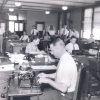calsfoundation@cals.org
Pick and Shovel
The Pick and Shovel was the official newspaper of the Republic Mining and Manufacturing Company (a subsidiary of the Alcoa company, which mined bauxite ore to produce aluminum), based in Bauxite (Saline County). It was conceived by Leona Rucker, its first editor, to be “a friendly, informal newspaper for all of us and our families at Bauxite and at Drury.” In 1953, the Pick and Shovel won the highest award for editorial merit of all Alcoa plant publications in the United States. The paper’s original run lasted from January 1944 to May 1958, after which it went out of print. However, the most recent incarnation of the Pick and Shovel is as the official newsletter of the Bauxite Historical Association and Museum.
The Bauxite News, which preceded the Pick and Shovel, ran from June 1920 to January 1921. The editor of the Bauxite News reported in the last issue that, due to cuts in bauxite orders, the “company cannot, for the present, support the Bauxite News.” The community of Bauxite would not have a newspaper of its own for another twenty-three years.
Leona Whitman Rucker was a home economics teacher at Bauxite High School before she became the creator and editor of the Pick and Shovel. Her husband, John Samuel (Sam) Rucker, grew up in Bauxite. The two worked as staff writers for the Bauxite News, and after it ceased operations in 1921, they were sent by Alcoa to British Guiana, South America. There, she reportedly taught “Native girls” to cook, sew, and “take care of their bodies.” They both returned to Bauxite around 1930, and Sam Rucker was a deputy sheriff until his death in 1936. After approaching the Republic Mining and Manufacturing Company in Bauxite with the idea, Leona sought to create a newspaper that focused on the everyday lives of people living in the local mining communities of Bauxite and Drury, much like the Bauxite News had done before. The first issue of the Pick and Shovel was published on January 1, 1944.
During World War II, in 1944 and 1945, the Pick and Shovel encouraged people to buy war bonds and followed locals in their wartime efforts whether at home or abroad. It also advertised to farmers the advantages of growing so-called victory gardens to help address wartime food shortages. The paper also covered local sports, company functions, and the everyday activities of Alcoa employees and their families. After the war, the Pick and Shovel functioned like any other newspaper. Its staff members were drawn from the town itself, but the paper was printed and distributed by Alcoa. Local sports figures and future professional athletes such as Leon “Muscles” Campbell and Jack “Spadjo” Richards got their first exposure in the Pick and Shovel.
In 1944, aluminum production began to slow as the end of the war drew near. Mining continued even during the postwar years, but Alcoa soon found it to be more economical to mine bauxite ore in other places. Beginning in 1946, all government-built housing for Alcoa employees and their families in Bauxite was either sold, moved, or razed. In 1952, Alcoa built a $54 million processing plant at Bauxite that employed about 1,000 people, but after the plant was operational, Alcoa decided that it no longer needed the expense of owning and operating the town of Bauxite. In light of this, in 1958, the original run of the Pick and Shovel ended, and Leona Rucker retired to Benton. Those who remained in Bauxite were notified in 1967 that the company-owned town would be abolished as of July 1, 1969. The facilities were abandoned or sold. The town of Bauxite incorporated with West Bauxite on January 16, 1973. At some point, Alcoa had collections of each issue of the Pick and Shovel from 1944 to 1958 bound into three hardcover volumes and distributed these to their employees.
The Pick and Shovel has remained important for historical use. Arkansas scholars study it to understand what life was like in a company-owned town during and after World War II. In 1968, Gordon Scott Bachus used the Bauxite News and Pick and Shovel in his landmark studies about the creation and effects of the aluminum industry in Arkansas from the late 1800s until well after World War II. In May 1968, while a graduate student at Ouachita Baptist University, Bachus wrote his thesis, “A Historical Analysis of the Socio-Economic Forces Which Shaped a Small Industrial Town in Arkansas,” using the Pick and Shovel to great effect. Bachus followed with his book A Written and Pictorial History of Bauxite, which was based on his thesis and supplemented with new information and pictures.
In April 1999, the Pick and Shovel was revived by the Bauxite Historical Association as its official newsletter. The first issue of the 1999 run was a page and a half long. At first, it was mailed to members of the Alcoa Employees Descendants Association. Its size increased to more than sixteen pages, using the same layout of the original paper. The circulation grew to just under 700. In 2009, a Christmas issue was introduced, mirroring the original paper, but after 2011 these issues came to an end. Now, the new version of the Pick and Shovel, which runs up to twenty-five pages, is printed twice a year, in March and September.
For additional information:
Bachus, Gordon Scott. A Written and Pictorial History of Bauxite. North Little Rock, AR: Heritage Publishing Company, 1968.
Morden, Ethel Lewellen. Bauxite: The Last Stop before Heaven. Waldron, AR: T&E Printing Service, 1987.
Cody Lynn Berry
University of Arkansas at Little Rock
 Mass Media
Mass Media World War II through the Faubus Era, 1941 through 1967
World War II through the Faubus Era, 1941 through 1967




Comments
No comments on this entry yet.